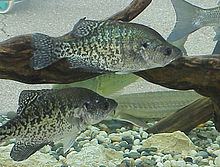White crappie
| White crappie | |
|---|---|
 |
|
| Scientific classification | |
| Kingdom: | Animalia |
| Phylum: | Chordata |
| Class: | Actinopterygii |
| Order: | Perciformes |
| Family: | Centrarchidae |
| Genus: | Pomoxis |
| Species: | P. annularis |
| Binomial name | |
|
Pomoxis annularis Rafinesque, 1818 |
|
The white crappie (Pomoxis annularis: Promoxis=opercle sharp; annularis=having rings) is a freshwater fish found in North America, one of the two crappies. Former common names include goldring and silver perch. The USS Goldring is named for the fish.
White crappies are morphologically similar to black crappies. They have 5–10 dark vertical bars along their body, rather than the randomly scattered spots like the black crappie. The white crappie has a silvery color with green or brown shades along its back, with dark lateral bars along its side and a white belly. The dorsal fin of the white crappie starts further back on the body than that of the black crappie. The anal fin is approximately the same size as the dorsal fin. The white crappie has 6 dorsal fin spines, whereas the black crappie has 7-8 dorsal fin spines. White crappies are also slightly more elongated than black crappie. The species is a deep-bodied fish with a flattened body, or a depth that is one-third of the length of the fish. White crappies have spinous rays and ctenoid scales, Fish Scales found in advanced teleosts. The exposed part of the scale has tiny tooth like projections (cteni). Both species of crappie have a terminal mouth position with many small conical teeth. The teeth occur in two rows along the mouth and are called cardiform, because they resemble a tool used for wool carding. White crappie belong to the Infraclass Teleostei, which is one of three infraclasses in the class Actinopterygii.
The white crappie rarely exceeds two pounds, and lives around 2–7 years. White crappies are generally 9-10 inches in length. The current for all-tackle fishing world record for a white crappie is 2.35 kilograms (5.2 lb).
White crappies are native to the Great Lakes, Hudson Bay, and the Mississippi River basins expanding from New York and southern Ontario westward to South Dakota and down southward all the way to Texas. This species has a large geographic range in the United States and currently has a stable population. Currently, this species is listed as a least concern for requiring conservation efforts.
...
Wikipedia

